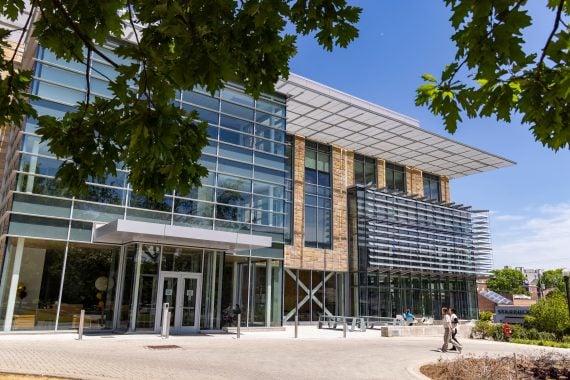Just a few years ago, most of the world’s leading Master in Management (MiM) programs could be found in Europe. Now, they’re gaining popularity in the U.S., with programs springing up across a number of top business schools.
Let’s take a look at how the MiM works, why it’s an appealing choice for so many, and which business schools offer these programs.
What Is a Master in Management (MiM)?
A Master in Management (MiM) program offers a graduate degree designed for recent college graduates seeking a management education to launch a business career.
Typically, MiMs are full-time, on-campus programs, spanning 10 months and kicking off in either August or September. They’re open to recent college graduates from any college major except for undergraduate business majors, attracting applicants from a range of different backgrounds.
How Does an MiM Compare to an MBA?
The aim of both programs is to train its students to be future managers by providing foundational business knowledge and general management training across a broad range of topics. And, as with an MBA, students in MiM programs will likely have the chance to specialize in concentrations such as finance, international business, analytics, and operations management.
Sounds pretty similar – but there are some crucial differences between the MiM and the traditional MBA.
The most significant of these is the work experience requirement. Unlike an MBA, MiMs usually require their applicants to have little or no work experience – with some MiM programs even stipulating that applicants can only have a maximum of two to three years of work experience. According to a survey conducted by GMAC, 76% of MiM applicants have less than two years work experience, compared to the three to five years of work experience amongst MBA applicants.
This makes the MiM very appealing to younger, less experienced applicants who want to begin their business career as soon as possible.
Other key differences include program length (most MiM programs are ten months long compared to two years for most Full time MBA programs) and average age of applicant (the typical MiM student is 22-23 years old compared to 25-27 years old for the typical Full time MBA student.)
How and Why are MiMs Popular?
The Master’s in Management degree is growing relative to full time MBA programs. According to a Graduate Management Admissions Council (GMAC) report, between 2021 and 2022, there was a 3.2% increase in applications to specialized master’s programs, such as the MiM, compared to a 6.5% decrease in applications to the traditional MBA.
Why is this? Students approaching college graduation want more management education options. For example, enrolling in a MiM program provides an efficient way for students to gain a management education and a business network right after college, allowing recent graduates to start their business career at a higher-level job than they could with just a college degree.
According to the AACSB, the MiM may also provide a buffer. With uncertainty brewing in the job market, MiMs allow business hopefuls to remain in education, nurture their networks and build concrete skills, all while waiting for economic unrest to blow over.
And finally, from the perspective of the business schools, the addition of MiM programs adds a new way for schools to offer management education to meet the needs of recent college graduates.
How Do MiM Graduates Fare?
The MiM degree is versatile, launching varied careers for its graduates, and job placement rates and earning statistics are impressive. According to Forbes, top MiM programs regularly report employment rates of over 90% immediately following graduation – and the job offers are lucrative, with GMAC reporting the median salary for MiM graduates as $95,000 in 2022.
An added bonus is the lower price tag of an MiM – since they tend to be shorter than MBAs programs. They also equal less time out of the job market and entry into business careers at an earlier point in life.
Deferred Enrollment MBAs and How They Link to MiMs
While both MiM programs and deferred enrollment MBA programs market their programs to college seniors and recent college graduates seeking management education, there is a key difference.
A deferred enrollment MBA allows college seniors to gain admission to a full-time program but defer the enrollment start date by two to five years to gain work experience in the interim. They’re an appealing prospect, since it allows a student to gain a few years of post-college work experience while already knowing that they are accepted at a top business school. In contrast, a college graduate accepted into a MiM program is expected to start the MiM program right away.
Another difference is that the deferred enrollment MBAs programs are more highly competitive than MiM programs, with top tier deferred enrollment programs running intensely selective admission processes. Applicants will need records of exceptional academic performance, clear and mapped-out career plans and demonstrable leadership ability.
Which U.S. Schools Already Have MiM Programs?
Cornell SC Johnson School of Business
Cornell’s MPS in Management program is a 10-month, full-time, in-person program. Applicants are encouraged who have recently graduated from college, and the program is STEM designated.
University of Michigan Ross School of Business
Michigan Ross’s MiM is a 10-month, full-time, in-person program. Applicants are encouraged who have up to two years of work experience. Applications are not encouraged from those who already have undergraduate business degrees. The program is not STEM-designated.
Duke’s Fuqua School of Business
Duke’s Master of Management Studies (MMS) program is a 10-month, full-time, in-person program. Applications are encouraged from recent college graduates with up to two years of work experience, and the program is STEM-designated.
Georgetown University McDonough School of Business
McDonough’s MiM is a 10-month, full-time, in-person program. Applications are encouraged from graduates who have up to three years of work experience, and the program is STEM-designated.
University of Maryland Smith School of Business
Maryland Smith’s MiM is a 10-month, full-time, in-person program. Applicants are encouraged who have up to three years of work experience, and the program is STEM-designated.
Northwestern Kellogg School of Management
Northwestern Kellogg’s MiM is a 10-month, full-time, in-person program. Applicants are encouraged who have up to two years of work experience. Applications are not encouraged from graduates who already have undergraduate business degrees. The program is STEM-designated.
Notre Dame Mendoza College of Business
Notre Dame Mendoza’s MS in Management (MSM) is an 11-month full-time, in-person program. Applicants are encouraged who have up to two years of work experience. Applications are not encouraged from graduates who already have undergraduate business degrees. The program is STEM-designated.
Which Schools Have Recently Added MiM Programs?
University of Chicago Booth School of Business
Chicago Booth’s MiM program began in August 2024, and is a 10-month, full-time, in-person program located on the University of Chicago campus in Chicago, Illinois. The program encourages applications from recent college graduates with liberal arts and STEM, and from those with less than two years of work experience. It does not encourage applications from those who have an undergraduate business degree.
Emory University’s Goizueta Business School
Emory Goizueta launched its new Masters in Management (MiM) program in 2024, beginning in August. This too is a 10-month full time in person program, and is STEM-designated.









